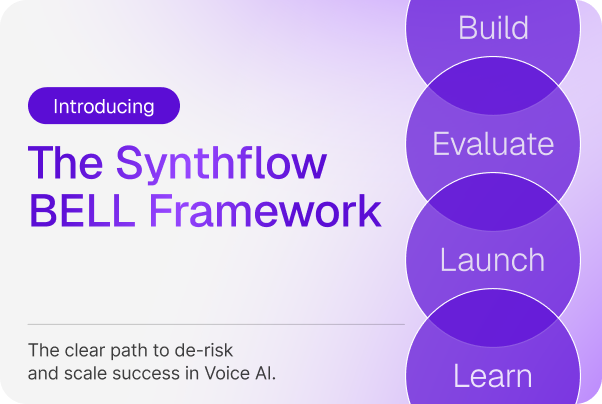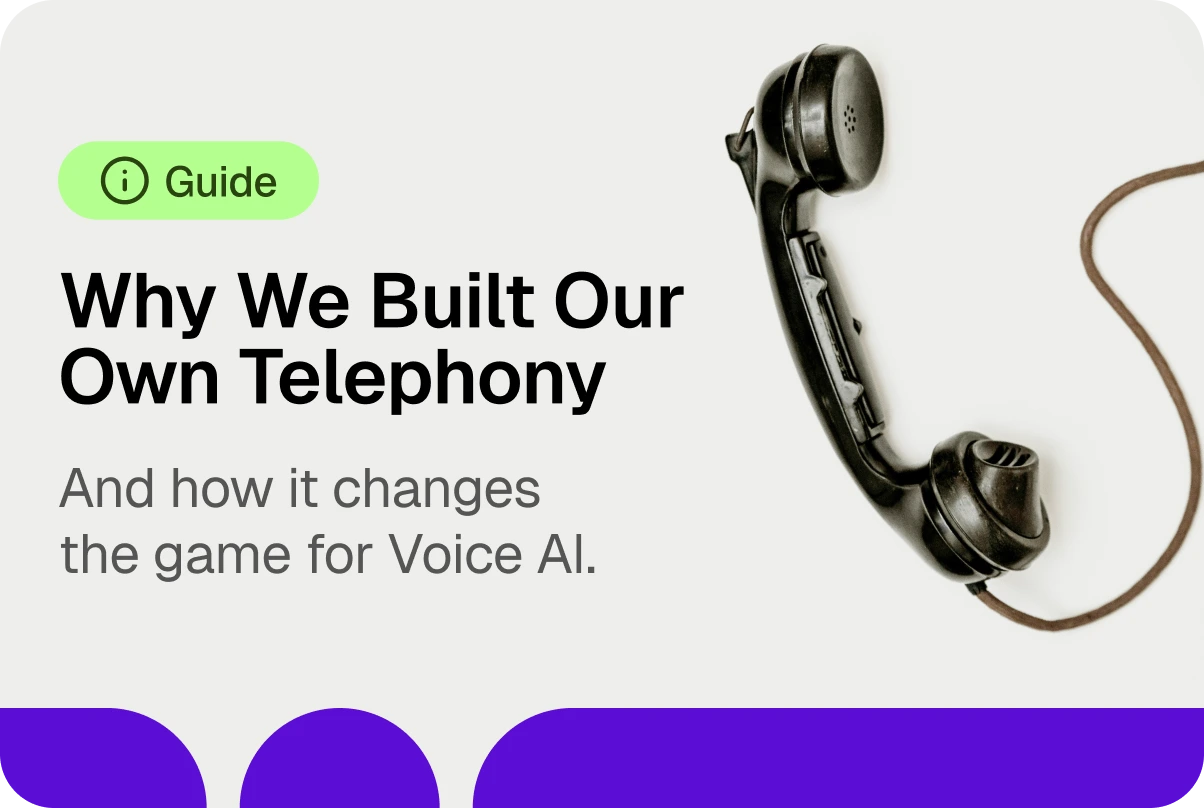Conversational AI
10 Best AI Voice Agents for Customer Support in 2025 (Tested & Reviewed)

Table of Contents
.avif)
In 2025, conversational AI has evolved from static IVR trees into real-time, context-aware voice systems capable of empathetic, multilingual dialogue. Modern AI voice agents combine speech recognition, natural language processing, and advanced text-to-speech synthesis to provide service experiences that sound natural and human-like.
For businesses, these tools are no longer experimental. They reduce wait times, scale operations instantly, and maintain compliance across healthcare, finance, and global support lines. Based on hands-on testing and deployment data, the following are the ten best AI voice agent platforms for customer support in 2025.
Quick Comparison of the Best AI Voice Agents for Customer Support in 2025
1. Synthflow (Best AI Voice Agent Platfrom)
Synthflow leads in balanced performance, usability, and compliance. The platform enables teams to design intelligent support agents using a drag-and-drop interface and built-in GPT testing sandbox. With latency under 500 ms and 50+ language support, Synthflow powers thousands of concurrent calls without degrading quality.
Pros:
- Sub-500 ms latency ensures real-time conversation flow
- No-code visual builder with live GPT testing tools
- Transparent pricing ($0.08 per minute) with volume discounts
- Full compliance: SOC 2, HIPAA, ISO 27001, GDPR
- 24/7 customer support and onboarding specialists
- Persistent memory and multi-prompt conversation handling
- SIP trunking, Twilio, and BYOC integration
Cons:
- 14-day trial only; no permanent free tier
- Some advanced workflow logic requires brief learning curve
Best For: Organizations like call centers, BPOs & needing scalable, compliant, and multilingual AI customer support that can be deployed rapidly without developer overhead.
2. CloudTalk AI Voice Agent
CloudTalk’s AI Voice Agent brings intelligent automation to customer support and sales teams by pairing natural-language call handling with CloudTalk’s battle-tested VoIP infrastructure. It manages repetitive inquiries, qualifies leads, routes calls, and retrieves information instantly—allowing human agents to focus on complex, high-value conversations. With deep CRM integrations, real-time analytics, and global telephony coverage, CloudTalk delivers an AI calling experience designed for scale, speed, and reliability.
Pros:
- Human-like voice interactions with multilingual and multi-accent support
- Fully automated inbound/outbound calls with intelligent routing & call transfers
- Customizable tone, fallback responses, and option to use your preferred LLM
- Deep CRM integrations (HubSpot, Salesforce, Pipedrive, Zendesk & more)
- Voicemail detection, data capture, and conversation personalization
- Pay-as-you-go pricing at €0.25 per agent minute, scalable for any team
Cons:
- Requires some initial setup to tailor workflows and responses
- More focused on business communication than entertainment/creative TTS
- Advanced capabilities work best when paired with CloudTalk’s broader telephony suite
Best For: Teams that want an AI voice agent tightly integrated into their communication stack—especially sales and support operations needing intelligent call handling, instant data syncing, and enterprise-grade global calling.
3. Bland AI
Bland AI targets large call centers requiring massive concurrency and throughput. Capable of handling up to 8,000 calls simultaneously, it automates routine inbound queries efficiently but lacks visual design simplicity.
Pros:
- Strong scalability for enterprise-grade call volumes
- Reliable performance across distributed regions
- Persistent memory for contextual continuity
- 24/7 live answering and routing support
Cons:
- Lacks no-code tools or GUI customization
- Latency averages ~800 ms
- Complex modular pricing with hidden add-ons
- Limited emotion and tone configuration
Best For: Enterprises with high-volume inbound traffic needing robust infrastructure more than flexibility or ease of setup.
4. Vapi AI
Vapi AI is an API-centric system for developers building custom voice workflows. It offers granular control over speech-to-text, TTS, and logic routing, though it demands technical skill.
Pros:
- Highly customizable through modular APIs
- Quick deployment (1–2 weeks) for engineering teams
- Predictable scaling at ≈ $0.13 per minute (all components)
- Compatible with Twilio and SIP telephony options
Cons:
- No visual builder; developer knowledge required
- Latency between 700 and 1,500 ms depending on setup
- Fragmented billing by component (STT, TTS, etc.)
Best For: Technical teams seeking maximum customization and integration flexibility for voice automation within their own software stack.
5. Retell AI
Retell AI deserves a second mention for its specialized call analytics suite. Beyond enabling compliant voice automation, it provides deep post-call insights, sentiment detection, and reporting tools used by QA and training teams.
Pros:
- Advanced transcription and conversation intelligence
- Sentiment and tone analysis for QA
- Post-call summaries and searchable logs
- Flexible pay-as-you-go pricing
Cons:
- Limited conversation-building tools
- More analytics-focused than agent-focused
- Customization options are fewer compared to Synthflow or Vapi
Best For:
Support teams prioritizing call insights, analytics, and compliance tracking rather than just conversational automation.
6. Sierra AI
Sierra AI targets high-security, compliance-heavy enterprises that require end-to-end governance and precision control over customer interactions. It is designed for industries where oversight, auditability, and consistent data handling matter as much as conversational performance. Unlike lighter tools, Sierra AI’s deployments often include IT and compliance teams to align workflows with enterprise data policies.
Pros:
- Full enterprise-grade security (SOC 2, ISO 27001, and HIPAA certifications)
- Dedicated onboarding with project management support
- Visual conversation builder for controlled dialogue paths
- Supports multi-region deployment for global teams
- Persistent data storage and audit reporting
Cons:
- Lengthy deployment time (six to eight weeks)
- Pricing is custom and often starts above $150,000 per year
- Higher latency (>1 second) during peak traffic
- Limited innovation speed due to strong internal controls
Best For: Organizations that need regulated, auditable, and controlled AI voice deployments, especially in industries such as banking, healthcare, and government.
7. Poly AI
Poly AI is a leader in conversational depth and realism. Its proprietary natural dialogue models allow agents to handle multi-turn, unpredictable customer conversations with human-like recall. The platform’s conversational intelligence has been trained across millions of real-world interactions, helping it deliver continuity and empathy beyond scripted logic.
Pros:
- Handles complex multi-intent conversations with contextual awareness
- Supports natural interruptions and turn-taking for human-like flow
- Multi-speaker and emotion recognition capabilities
- Strong enterprise compliance (SOC 2, ISO 27001)
- Integrates with major telephony and CRM platforms
Cons:
- Expensive enterprise contracts with custom pricing only
- Setup can take one to two months
- Requires significant training data for optimal performance
- Limited self-service customization options
Best For:
Enterprises managing highly conversational or complex support interactions, such as travel, insurance, utilities, and telecommunications sectors where customers discuss multiple issues per call.
8. Kore AI
Kore AI blends conversational automation with workforce optimization. It stands out for its deep integrations with leading analytics and QA platforms like NICE, Verint, and Calabrio. The result is a system that not only automates voice support but also measures quality, compliance, and agent performance within the same ecosystem.
Pros:
- Advanced compliance and analytics integrations (NICE, Verint, Calabrio)
- Certified for HIPAA, PCI-DSS Level 1, and SOC 2
- Visual workflow editor with granular QA and agent performance tracking
- Comprehensive audit and reporting tools for regulated operations
- Reliable at scale (10,000+ concurrent call capability)
Cons:
- High entry cost (typically $300,000+ per year)
- Requires enterprise-level IT involvement for setup
- Slower innovation cycles due to heavy customization
- Latency above one second in global deployments
Best For: Enterprises that need voice automation combined with compliance-grade analytics, such as financial institutions or regulated BPO operations.
9. Parloa
Parloa is a European-built voice AI platform known for its strong multilingual coverage and CRM integration. With a no-code interface and support for 35+ languages, it empowers customer support teams to design compliant conversational flows while aligning with data protection laws like GDPR.
Pros:
- Multilingual coverage with native-like accents and regional tones
- GDPR and ISO 27001 certified for EU compliance
- Intuitive no-code dialogue builder for support teams
- Seamless Salesforce and Microsoft Dynamics integration
- SIP and telephony flexibility for hybrid call centers
Cons:
- Deployment time of one to three months depending on setup complexity
- Custom pricing for enterprise clients only
- Occasional latency spikes (~700 ms) during multi-language sessions
- Limited developer APIs compared to Vapi or Synthflow
Best For: European companies or multinational support centers seeking GDPR-compliant, multilingual AI voice solutions that integrate directly with CRM and telephony systems.
10. Cognigy
Cognigy is one of the most mature conversational AI orchestration platforms on the market. It combines voice and chat automation under one umbrella, enabling enterprises to build end-to-end, omnichannel workflows. Cognigy is favored by Fortune 500s for its ability to connect complex back-end systems such as SAP, ServiceNow, and Salesforce with AI-driven customer service flows.
Pros:
- Enterprise-grade orchestration across 40+ languages and channels
- Certified for SOC 2, HIPAA, PCI-DSS, and ISO 27001
- Robust API ecosystem and integration library
- Advanced automation logic and real-time analytics dashboard
- Strong partner ecosystem for implementation and support
Cons:
- Costly (around $300,000–$500,000 per year for enterprise licenses)
- Long setup time (two to four months) due to system complexity
- Requires technical expertise to maintain and scale
- Overkill for small or mid-size businesses
Best For: Global enterprises with multi-departmental customer support operations that need consistent, secure automation across phone, chat, and digital channels.
11. ElevenLabs
ElevenLabs excels in lifelike voice synthesis. Its emotionally nuanced text-to-speech engine produces human-sounding tones across 30+ languages, making it ideal for brands that value conversational warmth and emotional resonance.
Pros:
- Exceptional voice realism and prosody control
- Low latency (~400 ms average)
- Intuitive testing environment for tuning voice output
- Multilingual support and accent adaptability
- Transparent pricing and enterprise reliability
Cons:
- Limited automation and support-specific features
- Expensive enterprise plans (from $150K per year)
- Minimal onboarding for smaller users
Best For: Brands prioritizing emotional tone and voice authenticity; for example, luxury services, hospitality, and healthcare helplines seeking natural empathy.
FAQs: AI Voice Agents for Customer Support in 2025
1. How do AI voice agents improve customer service?
They respond instantly, reduce wait times, and resolve common questions automatically. Synthflow helps support teams stay available 24/7 while improving first-call resolution and customer satisfaction.
2. Can AI voice agents replace human agents?
No, but they reduce repetitive workloads. Synthflow handles routine calls so human agents can focus on complex or sensitive issues.
3. How do they detect customer frustration or emotion?
Synthflow’s voice configuration and NLP recognize tone and emotion. The system adjusts responses or routes the call to a human when needed.
4. What results can businesses expect from using Synthflow?
Companies report lower handling times, fewer missed calls, and higher satisfaction scores after switching to Synthflow-powered automation.
5. How does Synthflow manage live transfers?
It transfers calls smoothly, sending full conversation history and summaries to human agents so customers never repeat themselves.
6. Is Synthflow good for multilingual support?
Yes. It supports more than 30 languages and regional accents, making it suitable for global customer operations.
7. Is customer data secure with Synthflow?
Yes. Synthflow is SOC 2, HIPAA, and GDPR compliant with end-to-end encryption and secure data handling.
8. How long does Synthflow take to deploy?
Most teams go live within three weeks using its no-code setup and prebuilt workflows.
9. Can Synthflow learn from previous interactions?
Yes. Its persistent memory feature allows it to recall customer preferences and previous calls for smoother follow-ups.
10. Why is Synthflow the best AI voice agent for support in 2025?
It combines fast response times, strong compliance, simple setup, and reliable multilingual performance, making it the top choice for modern customer service teams.



